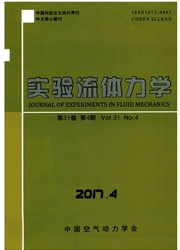

 中文摘要:
中文摘要:
耦合传导/辐射情况下的传热参数和表面热流辨识问题是一类特殊的传热逆问题,在工程上应用较广。本文首先建立了耦合传导/辐射的传热问题的数值方法,进行了算例验证。然后分别建立了同时辨识材料热物性参数和辐射吸收系数的算法、辨识非稳态表面热流密度的算法;分析了测点位置、测量误差、辐射吸收系数对辨识结果的影响。结果表明:同时辨识材料热物性参数和辐射吸收系数时,利用右端测点的温度辨识出热传导系数值的精度较高,利用中间测点温度辨识出的辐射吸收特性系数值精度较高。对于表面热流的辨识,测点越靠近加热面,辨识结果的精度越高;吸收系数对中间测点的辨识结果影响大于其他位置测点的辨识结果。
 英文摘要:
英文摘要:
Inverse coupled heat conduction-radiation problem is a special kind of Inverse Heat Transfer Problem(IHTP)and of significant value in engineering practice.At first,the numerical method for solving the conduction-radiation coupled differential equations are presented and validated in this paper.Secondly,the inversion algorithm to estimate the heat transfer coefficients of thermal conductivity and the absorption coefficient simultaneously,and the algorithm to estimate the unsteady surface heat flux with the conduction-radiation coupling effect taken into account,are developed.And the influences of measurement accuracy,measurement position and absorption coefficient on the estimation result are also investigated.The results show that when the thermal conductivity and the absorption coefficient are estimated simultaneously,the least uncertainty in the estimated thermal conductivity is achieved through the measurement point located near the right boundary,while the least discrepancy of the estimated absorption coefficient comes out from the measurement point located in the middle.As for the estimated result of surface heat flux,the nearer the measurement position is to the heated surface,the better the estimation result is.The influence of the absorption coefficient on the estimated result is greater for the measurement point located in the middle compared to measurement points located elsewhere.
 同期刊论文项目
同期刊论文项目
 同项目期刊论文
同项目期刊论文
 期刊信息
期刊信息
